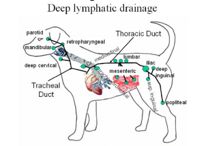Lymphatic Vessels - Anatomy & Physiology
Introduction
Lymphatic vessels are part of the lymphatic system and transport lymph.
Development
The lymphatic system develops after the circulatory system and similarly to blood vessels, lymphatic vessels develop from mesoderm via angio & vasculogenesis.
Structure
Unlike the circulatory system for blood the lymphatic system is open and does not have a central pump. Lymph flows through the system in one direction.
The smallest lymphatic vessel is called a lymphatic capillary and these are blind ending vessels consisting of endothelium with a highly perforated basal lamina. This means that lymphatic capillaries are thinner and more permeable than their blood counterparts.
The capillaries feed into larger vessels called lympathic vessels and these have smooth muscle their walls and they pass through lymph nodes. These vessels eventually feed into two large ducts, the thoracic and the tracheal, which empty into the jugular veins. The thoracic duct empties into the veins of the left side while the tracheal to those on the right.
The smaller vessels generally travel with blood vessels and nerves. Valves in the vessels prevent back flow and keep the flow of lymph unidirectional. As there is no central pump the movement of lymph is largely dependant on skeletal muscular activity.
Tracheal duct
The tracheal ducts are paired and originate from the retropharyngeal nodes (except horse) of the head. They run along the trachea before emptying into the thoracic and right lymphatic ducts or may empty directly into the jugular veins.
Thoracic duct
Originating from the cistern chyli it passes through the aortic hiatus, travelling cranially through the mediastinum and along the left side of the trachea until it empties into the cranial vena cava or commonly the left jugular vein.
The thoracic duct drains lymph from the left side of the thorax as well as from the cistern chyli. The cistern drains the abdomen, hind limbs and the pelvic regions.
It is the main channel for return of lymph to the bloodstream, receiveing lymph from the efferent vessels of the viscera, pelvis and bloodstream.
Function
Due to their structure lymphatic capillaries are more permeable than vascular capillaries and this mean that they can not only more effectively remove fluid from tissue but also take up large molecules. This allows the lymphatic system to transport large proteins as well as chylomicrons for the transport of fats. The interstitial fluid filtered into the lymphatic vessels is called lymph. As the vessels pass through lymph nodes the lymph is surveyed by immune cells before returning to the blood ensuring that antigens/pathogens from tissues are removed.
Circulation
Tissue fluid is collected by the afferent lymphatic vessels which drain into the lymph node where trapping of foreign material occurs to prevent spread around the body. The filtered lymph leaves the lymph node via the efferent lymphatic vessel.
- The thoracic duct terminates in the left brachiocephalic vein
- The left tracheal duct supplies lymph to the thoracic duct from the lymph nodes draining the left head and neck
- The right tracheal duct receives lymph from the right head and neck and supplies lymph to the right brachicephalic vein
| Originally funded by the RVC Jim Bee Award 2007 |
